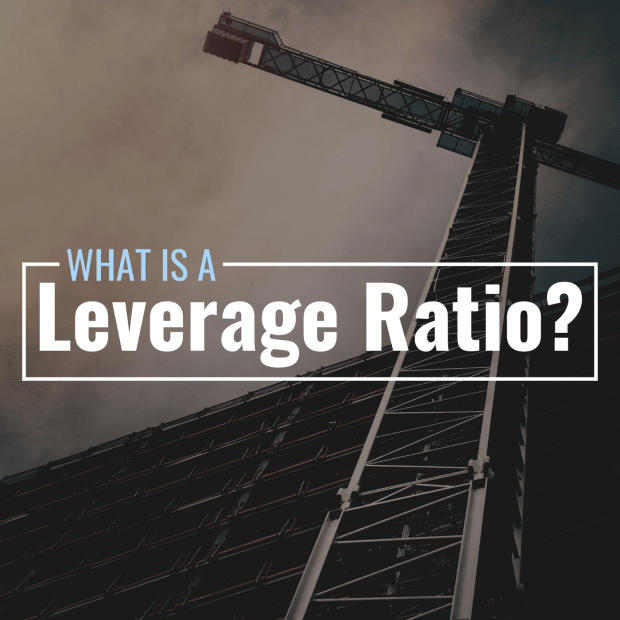
Businesses cost a lot of money to run, and that money has to come from somewhere. After all, it takes money to make money. Typically, businesses fund their operations with a mix of loans and equity.
Loans are borrowed sums of money that must be paid back over time with interest, and equity is ownership in the business itself. Publicly traded companies issue stock (equity) to the public in exchange for capital.
What Is a Leverage Ratio and What Does It Tell Us?
A leverage ratio is a metric that expresses the degree to which a company’s operations are funded by debt (borrowed capital). The most popular leverage ratio—the debt-to-equity ratio—compares a company’s debt to its owners’ equity. Companies whose operations are funded primarily through debt (in other words, companies with high debt-to-equity ratios) are described as being very “leveraged.”
Leverage isn’t necessarily a bad thing. It is normal for companies—especially newer companies and those in growth phases—to borrow capital in order to develop and expand. So long as payments are made on time, expansion can continue and additional borrowing remains an option.
That being said, the more debt a company carries relative to its equity and/or assets, the riskier of an investment it can be for shareholders. In the event that a company’s revenue isn’t high enough to keep up with its debt, it may become insolvent and could even go bankrupt.
What Are the 2 Main Leverage Ratios?
As mentioned above, the most popular leverage ratio used by investors to examine a company’s reliance on debt is the D/E ratio, which compares debt to equity directly. Another commonly used metric is the debt-to-total assets ratio. This ratio expresses the proportion of a company’s assets that are financed with borrowed money.
Note: Short and long-term debt, shareholders’ equity, and total assets can all be found on a company’s public financial statements.
1. Debt-to-Equity Ratio
To calculate a company’s debt-to-equity ratio, simply divide its total debt by its shareholders’ equity.
Debt-to-Equity Ratio Ratio Formula
D/E = (Short-Term Debt + Long-Term Debt) / Shareholders’ Equity
2. Debt-to-Total Assets Ratio
To calculate a company’s debt-to-total assets ratio, divide its total debt by its total assets.
Debt-to-Total Assets Ratio Formula
D/TA = (Short-Term Debt + Long-Term Debt) / Total Assets
How to Interpret a Company’s D/E Ratio
A D/E ratio of 1 (this can also be expressed as 100% or 1:1) indicates that a company’s operations are funded equally by debt and shareholders’ equity. In other words, its debt and equity are equal. A ratio of less than 1 indicates that more of a company’s operations are funded by equity than debt, while a ratio of more than 1 indicates the opposite—that more of a company’s operations are financed by debt than by equity.
How to Interpret a Company’s D/TA Ratio
A D/TA ratio of 0.5 (this can also be expressed as 50%) indicates that half of a company’s assets were financed with debt and half were financed with equity. A ratio of below 0.5 means that more of a company’s assets were funded by equity than debt, while a ratio of above 0.5 means the opposite—that more of a company’s assets were paid for with borrowed cash than with equity.
When Are Leverage Ratios Useful?
Leverage ratios—like most financial metrics used by investors to evaluate companies—are most useful when comparing two or more companies within the same industry. Different industries have different norms in terms of debt and financing, so comparing the leverage ratio of a bank to that of an automaker would not provide much insight.
Comparing the leverage ratios of two companies within the same industry, on the other hand, could provide valuable information about which might be a safer investment. It’s important to note, however, that safer investments aren’t always better investments. Riskier investments can provide more substantial returns, but they can also result in larger losses.
In the section below, we use leverage ratios to compare Microsoft and Apple, two large and popular computer companies.
Leverage Ratio Example: Microsoft vs. Apple
Comparing the leverage ratios of Microsoft (Nasdaq: MSFT) and Apple (Nasdaq: AAPL) can’t tell us which company is a better investment, nor can it tell us which company’s stock price is a better value. It can, however, tell us how reliant on debt each company currently is to sustain its operations. In times of economic uncertainty—like bear markets and recessions—companies that are less reliant on debt may be safer investments.
Note: The figures below come from the 2021 financial statements of Microsoft and Apple.
Microsoft’s Leverage Ratios
Debt to Equity
D/E = (Short-Term Debt + Long-Term Debt) / Shareholders’ Equity
D/E = (1.96 + 71.45) / 141.99
D/E = 73.41 / 141.99
D/E = 0.517
Debt to Total Assets
D/TA = (Short-Term Debt + Long-Term Debt) / Total Assets
D/TA = (1.96 + 71.45) / 333.78
D/TA = 73.41 / 333.78
D/TA = 0.219
Apple’s Leverage Ratios
Debt to Equity
D/E = (Short-Term Debt + Long-Term Debt) / Shareholders’ Equity
D/E = (7.45 + 119.38) / 63.09
D/E = 126.83 / 63.09
D/E = 2.01
Debt to Total Assets
D/TA = (Short-Term Debt + Long-Term Debt) / Total Assets
D/TA = (7.45 + 119.38) / 351
D/TA = 126.83 / 351
D/TA = 0.361
From these leverage ratios, it is clear that as of 2021, Apple was more debt-reliant than Microsoft.
Apple’s debt accounted for about twice as much of its operations as its equity, whereas Microsoft’s debt accounted for only about half as much of its operations as its equity. About 22% of Microsoft’s total assets were financed by debt, whereas about 36% of Apple’s total assets were financed by debt.
Overall, these metrics tell us that Apple is more highly leveraged than Microsoft and therefore might be a riskier investment (within the computer industry) during bear markets or periods of economic decline.
What Does a High Leverage Ratio Mean?
As mentioned above, one company’s leverage ratios being higher than another’s doesn’t mean much if the two companies are in different industries, especially if one has been around for a lot longer than the other.
Within an industry, however, if two companies are of similar size and age, and one has significantly higher leverage ratios, that could indicate that it is a riskier investment, especially during periods of low revenue. In the event that both companies have revenue troubles, the one with the higher leverage ratios is more likely to become insolvent.
What Does a Low Leverage Ratio Mean?
If two companies are comparable (in terms of industry, size, and age), but one has significantly lower leverage ratios than the other, the less-leveraged company could be considered a safer investment. If both companies struggle to achieve revenue, the less-leveraged company is less likely to become insolvent.
What Is a Good Leverage Ratio?
What is considered a “good” or below average leverage ratio varies considerably by industry, as certain types of companies are by nature more reliant on debt than others to fund operations. For instance, the average D/E ratio in the auto industry as of January 2022 was about 0.2, while the average for money center banks was 1.7.







